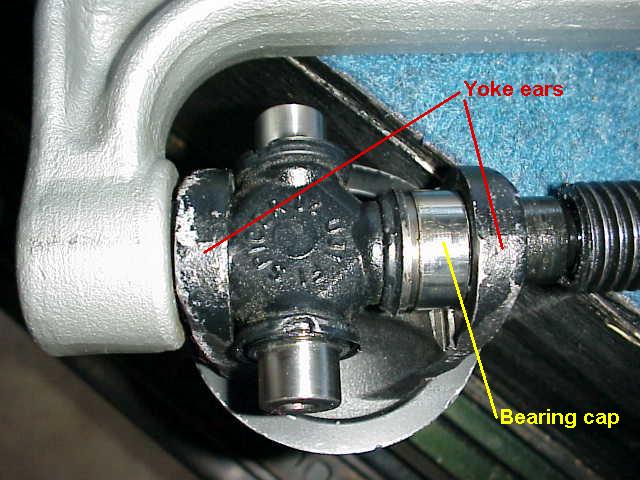I had picked up a set of D-30 inner and outer axle shafts from a friend in California when we wheeled the Rubicon together. Having gone to 35″ tires during my last lift, I thought it would be prudent to carry a set, “just in case”. It seems that when an axle u-joint goes, it often times takes the yoke ears with it. Having a spare u-joint sitting in the tool box doesn’t do much for you when that happens. Having a full set of ready spares does! The spare shafts I picked up needed new u-joints before being put in the Jeep as trail spares.
The outer shafts had old Spicer u-joints in them (looking pretty bad) so these would need to be removed before the new ones were installed. I had thought about doing this at my friends house, since he has a 25 ton shop press that would make short work of this job. But, I had a bought a u-joint press from Harbor Freight some time back and to date, I had only used it on someone else’s vehicle out on the trail. So, hey, why not break it out of the storage box and give it a try? Besides, that would give me a chance to take inventory in the box and figure out what was going with me to Moab next weekend. (Click here for a helpful trick for using the u-joint tool.)
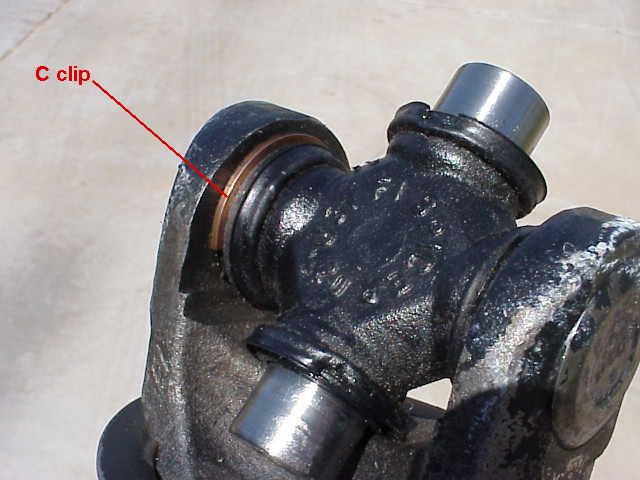
Here is the old u-joint, shown in the outer shaft yoke. I pulled the bearing caps off of the two free ends and set them off to the side. Note that it is VERY EASY for the bearing caps to slide off of the u-joint, hit the floor, and scatter the enclosed needle bearings ALL over the place. (been there, done that, probably will again!)
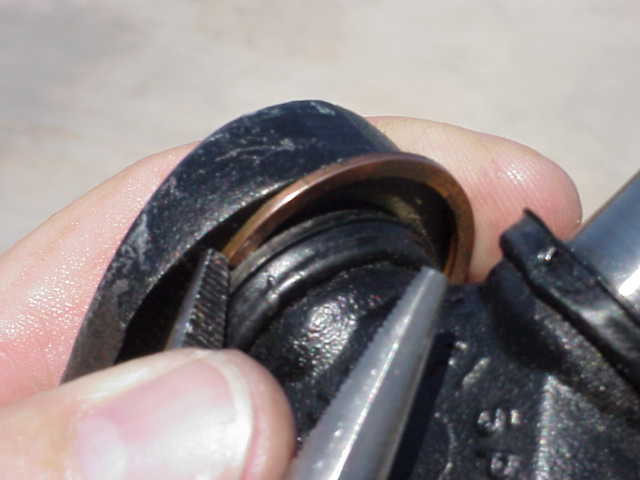
You need to remove the C clip from both sides of the u-joint. This does NOT take a special tool of any kind….just something you can use to pry the clip up and out of the groove it sits in, as shown in the above picture. I found that one of the jaws of a small pair of needle nose pliers made an easy removal of the C clip. Although the new u-joints I bought came with new clips, I kept the ones I removed and stashed them away in the storage box. You never know when you might need a spare (or your friend might for that matter).
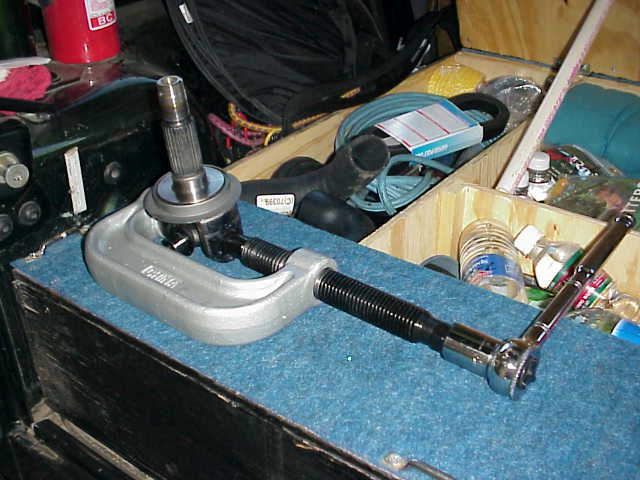
This is the Harbor Freight u-joint tool I mentioned at the beginning of the article. They sell for about $30 and the company seems to have them in and out of stock at various times. It is made in China but seems to work just fine. (hey, there is only 1 moving part….the big screw) It also works on ball joints and has some kind of use for pushing a brake pin out of a truck brakes (or something like that). I realize that some of you hard core folks like to use a big hammer and a couple of properly sized sockets to remove u-joints, but I prefer this method and highly recommend it. Everyone that has either used it or seen my use it was very impressed with how easy it is.
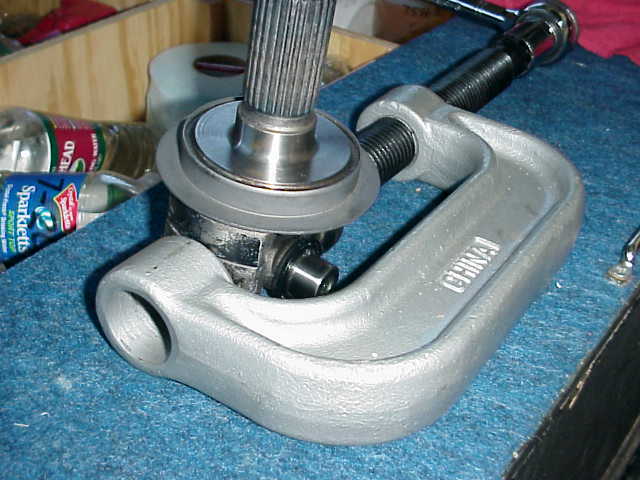
When using the Harbor Freight press to remove the u-joint, the bearing cap will be pushed into the large hole at the bottom of the tool, as shown above. I highly recommend this simple but effective tool as an addition to your off-road tool box.
U-Joint Replacement
In this picture, you can see how the screw has pushed the bearing cap through the yoke ear on the right side. At the same time, the left side bearing cap has been pushed out of the yoke an into the hole of the clamp. Loosen the screw and remove the u-joint from the clamp.
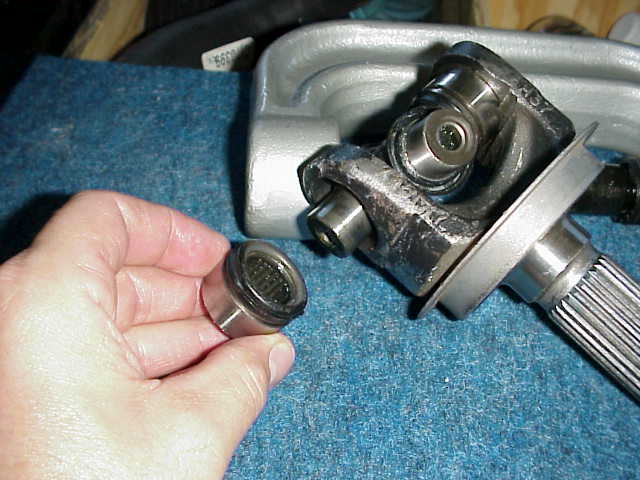
Pull the left side bearing cap off of the end of the u-joint. Although the right side bearing cap is now loose, you will not be able to remove it right now. You will need to turn the u-joint around in the clamp and press the u-joint back the other way. This will push the remaining cap out of the yoke, which is the only way that the bearing caps can be properly removed. Of course, if the caps are broken (common when a u-joint blows, you may need to improvise a bit when taking the caps off.

Remove the remaining bearing cap. The u-joint cross can now be removed from the yoke ears. You might want to take a few minutes and clean things up. Check the yoke and make sure it is still in good shape. As mentioned earlier, the ears will often times suffer damage when the u-joint blows.
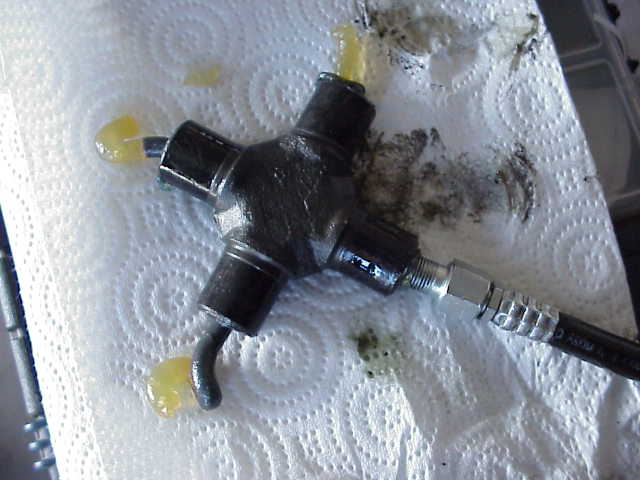
Here is something that may be new to you….or maybe you never gave it much thought….clean the garbage lubricant out of the new u-joint cross. As you can see in this picture, I am pumping new grease (I use a full synthetic) into the cross, using my needle point fitting on my grease gun. As you can clearly see, the yellow junk from the manufacturer is being pushed out the holes as the new grease displaces it. Use a paper towel as I did and just wipe everything off when you are done. Don’t forget to CAREFULLY wipe out the new bearing caps and remove the manufacturer’s lubricant from them as well. Once they are cleaned out, pump a couple of shots of grease into each cap and smear it around so that the bearings are fully lubricated.
Note: The newer Spicer 5-760x u-joints have specific instructions about NOT doing what I just showed in the picture. Read the manufacturer’s instructions and follow them. If there are no directions as for lubrication requirements, you are pretty much on your own. Here is some information I dug up in regards to u-joint lubrication.
U-Joint Replacement
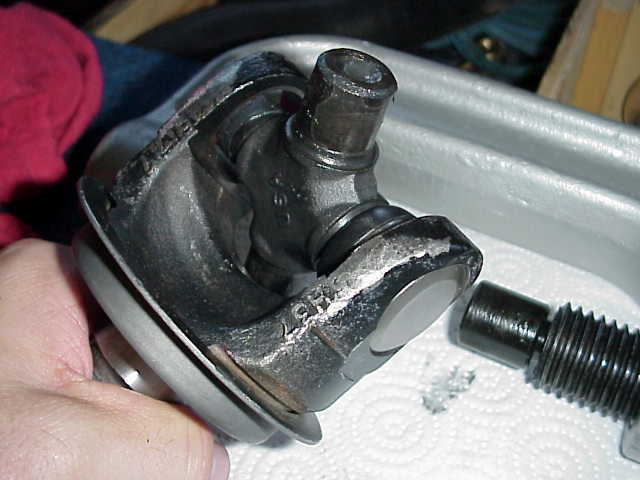
Insert the u-joint cross into the yoke and push a new bearing cap into the yoke ear. Make sure you get everything lined up properly. The cap should start a little way into the ear before meeting resistance, which makes it easy to get it started and then apply pressure using the u-joint tool.
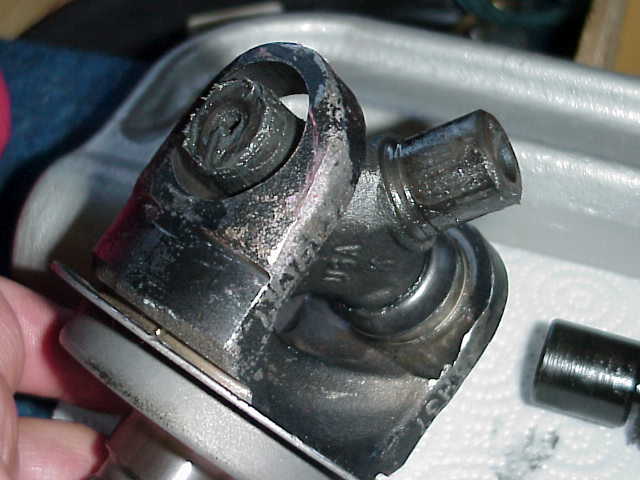
One of the caps has been pressed completely into position. Be sure to push the cap far enough into the ear so you can get to the C clip groove. I found that I could push the cap in just a bit more than needed. This made it very easy for me to install the C clip and ensure that it was fully seated in the groove. The little bit of extra distance that the cap was inserted is automatically corrected when the opposite bearing cap is installed.
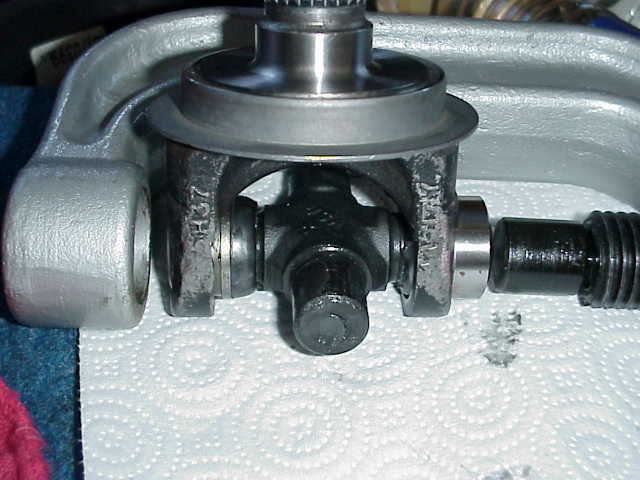
In the above picture, the left side bearing cap is already installed and I have started the right hand cap by hand. The yoke is properly positioned in the u-joint tool and the screw will then be cranked down and push the right side cap into position. You will be able to feel when the cap is completely seated as the tension on the clamp screw will quickly increase. Check to make sure that the C clip that you installed on the left side has now been pushed back up against the yoke ear. The C clip groove on the right bearing cap will now be clearly visible and you should have no problem inserting the clip. After the clip is installed, release the tension on the clamp screw. If you did a good job filling the grease channels in the cross, you should notice that some of the grease will have squeezed out of the two open ends of the cross while you were putting on the bearing caps.
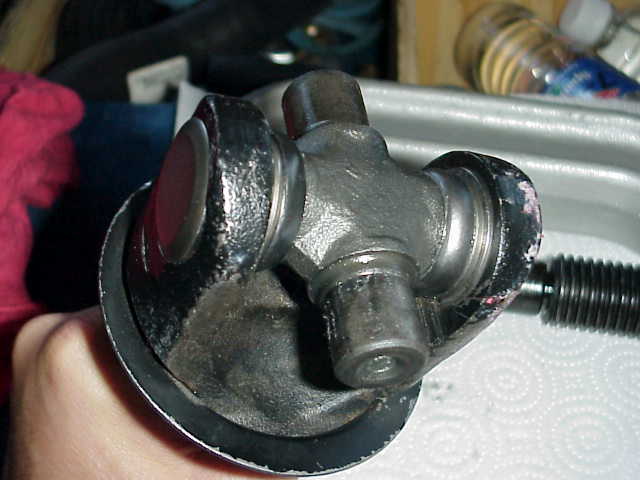
Here is the outer axle shaft with the new u-joint properly installed. Both C clips are in place. Check the rotation of the u-joint. It should move with slight resistance (mostly from that good quality grease you had pumped into the bearing caps.
U-Joint Replacement
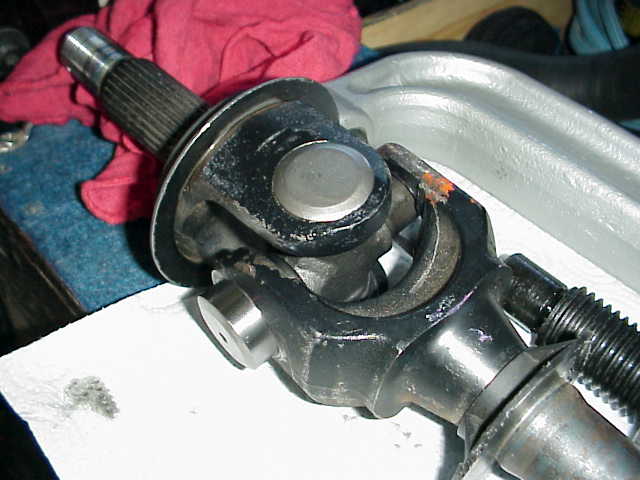
We now need to repeat the bearing cap install process, this time using the inner axle shaft. In the above picture, I have positioned the cross into the yoke ears of the inner shaft. I have also started one of the two remaining bearing caps into the yoke ear.
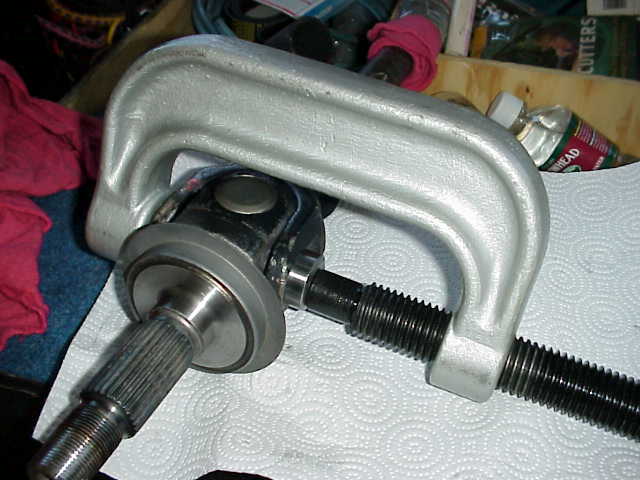
Once again, properly position the screw of the u-joint press on the center of the bearing cap and apply pressure. The cap will push into the yoke ear just as it did before.

After the cap is pushed into place (remember, I push mine just a bit further than the need to be), take a new C clip and install it in the groove on the bearing cap. Make sure the C clip fits properly in the groove. You don’t want to loose one of these on the trail, as it can cause the bearing cap to become loose and if this happens, the u-joint will surely fail. After the clip is in place, install the remaining bearing cap and then install its C clip as well. As this point, you will have a fully assembled u-joint.
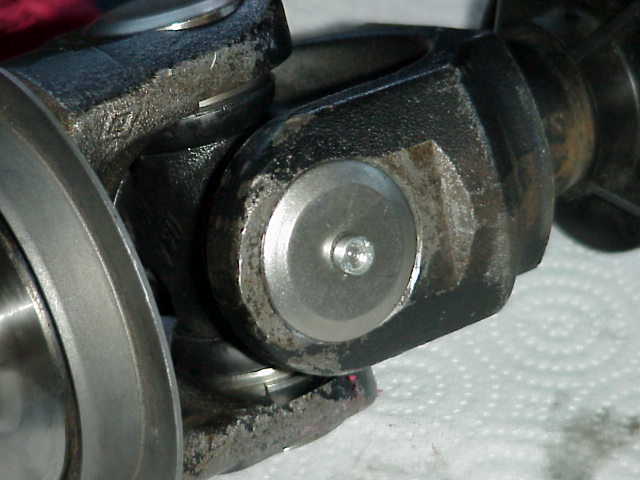
The u-joint I used (Napa 377 Extra Strength) comes with a screw in needle grease fitting. It is screwed into place with a flat blade screwdriver. Some folks don’t like greasable u-joints while others do. Me? Well, I am still trying to figure out which one is best. For now, I am pretty sure that these trail spare axle shafts will get me off of the trail before the u-joint fails because of a grease channel.
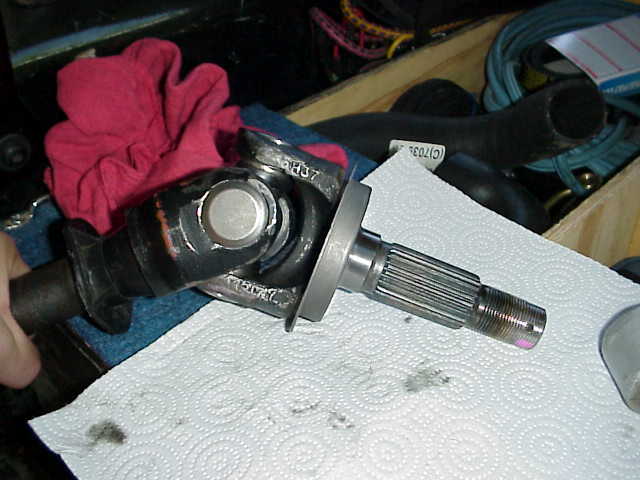
OK….that is all there is to it. Here is one completely overhauled u-joint.

From here, they get wrapped in that heavy duty shipping wrap (that industrial strength Saran Wrap) and put in the Jeep. With luck, I’ll never use them. But, if I do manage to take out a u-joint, I know I have a properly assembled spare shaft that will do the job. And hey….don’t forget to get yourself one of those handy Harbor Freight u-joint presses. I tell you, they make this kind of job so easy to do!

